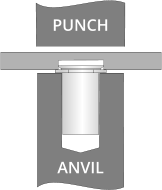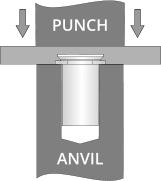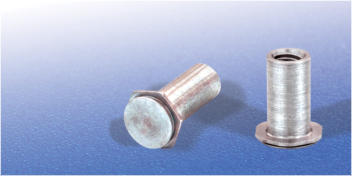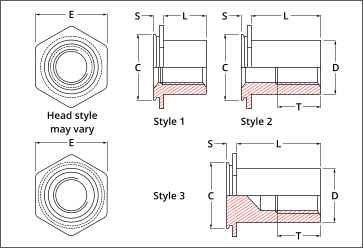


Self-Clinching Fasteners
Broaching Fasteners
Arnold & Shinjo Fasteners
Rivet Bushes
Rivet Nuts
Weld Fasteners
Cage Nuts
Blind Rivets
Inserts for Plastics
Inserts for Stone, Solid
Materials, Composites &
Sandwich Panels
Crown-Nuts
Fast-Con
Installation Equipment
Turned & Cold Formed
special parts made to order
Bespoke fastener design &
development
Fastener & Application
testing
Technical support
ISO 9001
RoHS|WEEE Compliance
REACH Compliance
Conflict minerals
Environmental Policy



SERVICES & SUPPORT







Clinch Nuts
Flush Nuts
Blind Nuts
Miniature Nuts
Nyloc Nuts
Locking Nuts
Floating Nuts
Flush Head Studs
Flush Head Studs for
Stainless Steel
Reduced Flush Head Studs
Thin Panel Non-Flush Studs
High Strength Studs
Thin Panel High Strength
Studs
Flush Head Pins
Flush Head Tapered Pins
Concealed Head Studs
Through & Blind Standoffs
Grounding Standoffs
Thin Panel Standoffs
Quick Release Standoffs
Keylock Standoffs
Concealed Head Standoffs
Flush Panel Screw Assembly
Panel Fasteners
Phillips Head Panel Fasteners
Low-Profile Panel Fasteners
Plunger Assembly
Self-Clinching fastener
Do’s and Don’ts
Self-Clinching fastener
problem solving guides
Self-Clinch in harder panels



NORTHERN PRECISION LIMITED
Specialist Fasteners
+44 (0) 1302 836010
sales@npfasteners.com




Contact us
You can contact us using any
of the methods below.
Unit 3 Durham Lane
Armthorpe
Doncaster
South Yorkshire DN3 3FE
England
+44 (0)1302 836010
sales@npfasteners.com


All rights reserved
© Northern Precision Ltd.
NORTHERN PRECISION LTD
Accreditations
Northern Precision Ltd operate a quality management
system in accordance with ISO 9001.
The ISO 9001 standard is recognised worldwide and
you can be assured of the benefits of working with a
certified company knowing that our management
systems are constantly assessed and approved.

Regulatory
RoHS|WEEE Compliance
REACH Compliance
Conflict Minerals Policy
Environmental Policy
Opening Hours
Mon - Thu
08:00 - 17:00
Fridays
08:00 - 16:30


Registered in England & Wales
Company number 3275391
V.A.T Registration number
GB 684 1384 17



Performance & Testing Method
Thread
size
Max. nut
tightening
Torque
(Nm)
M3





M4


M6
Pullout
(N)
1475
1800
1975
2000
2700
2900
Installation
(kN)
13
18
18
22
22
25
Pullout
(N)
1000
1200
1350
1300
1800
1950
Fastener
Type
NCS (A2)
NCSO (A2)
NCS (A2)
NCSO (A2)
NCS (A2)
NCS (A2)
Installation
(kN)
0.55
2.00
2.00
3.60
3.60
7.20
1350
12
900
NCSO (A2)
0.55
18
19
21
24
25
27
29

Steel test panel
Aluminium test panel






M5
All performance figures are averages obtained over a range of installations and should be used as an indicator
only. Panel material, hole preparation, installation tooling and method can affect part performance. We always
recommend that you carry out your own tests in the actual application. Please call our sales team and we will be
happy to provide you with samples as well as offering technical assistance.
Pull-out test for Self-Clinching Concealed Head Standoffs should be performed by the gradual application
of an axial load as shown.
A hardened bushing should be centred over the standoff collar and inserted into the test rig lower link. A
hardened bushing should be inserted into the test rig upper link and a bolt screwed down into the
standoff. An axial load is then gradually applied on a tensile testing machine to separate the links until a
failure point is reached.
Please note that the pull-out values obtained during this test do not indicate the axial strength of the
threads. Pull-out values pertain only to the amount of force required to pull the standoff out of the panel.





Tensile testing rig
upper link
Tensile testing rig
lower link
Hardened bushing
Hardened bushing




Applied Load.


Max Head Dia.
+1.0mm to +1.5mm









Bolt (Grade 5 min.) Ensure full thread
engagement (min. 6 threads recommended).

Installation



























A





Length of standoff
+6.35mm min.
Anvil Dimensions



A
+0.08
6.36
4.33
7.50
Thread
size
M4
M3
M5


9.13
M6
First mill a blind hole in the panel to the correct diameter and depth.
Place the fastener in to the anvil, then locate the hole over the shank of the fastener.
With the panel held level, apply a parallel squeezing force until the collar is installed flush to the panel surface.
Do not over squeeze the fastener into the panel as this will result in panel deformation.
When installing Self-Clinching fasteners, please pay attention to the minimum hole centreline to edge and
parent material hardness limitations.

Do not remove any extra material or
chamfer the hole as this could result in
improper installation or reduced
performance.
HRB (ROCKWELL HARDNESS B SCALE)
Ensure that you are installing into a
panel that is ductile and at or below the
published maximum recommended
hardness for the fastener.
Ensure that attention is paid to the
minimum hole centreline to edge
dimension for each fastener. Installing
too close to an edge or bend could result
in improper installation or reduced
performance. Minimum centreline to
edge dimensions shown for each
fastener apply to one edge only. If this
distance is applied on multiple sides
there will be significant panel distortion
unless the panel edges are supported
during installation.

Material & Finish
300 Series Stainless Steel (A2) parts are suitable for installation in ductile panels with a
maximum recommended hardness of 70 HRB.
Part Number Examples
Part number is made up as follows:
(Type)-(Thread)-(Length)-(Material/Finish Code)
For example:
NCSO-M3-10-A2 (Concealed Head Standoff-1.6mm minimum panel-M3 thread-10mm
long-stainless steel)
NCS-M4-10-A2 (Concealed Head Standoff-2.4mm minimum panel-M4 thread-10mm
long-stainless steel)

Info
Self-Clinching Concealed Head Standoffs provide strong captivated female threads in panels as thin as 1.60mm.
Utilising a special proven clinch feature, this fastener has excellent pull-out and torque-out characteristics.
Installed into a pre-prepared milled blind hole, it leaves the underside of the panel intact.
Like all self clinching fasteners they are installed using a parallel squeezing action, so require access to both sides of
the panel.
Concealed Head Standoffs are available in a range of thread sizes and lengths, manufactured from 300 series
stainless steel and are suitable for installation in ductile panels with a recommended maximum hardness of 70
HRB.
Dimensional Data
Self-Clinching fastener
Do’s & Don’ts
Self-Clinching fastener
problem solving guides
Downloadable
Data Sheet
Back

Type NCSO & NCS
SELF-CLINCHING
CONCEALED HEAD
STANDOFFS
